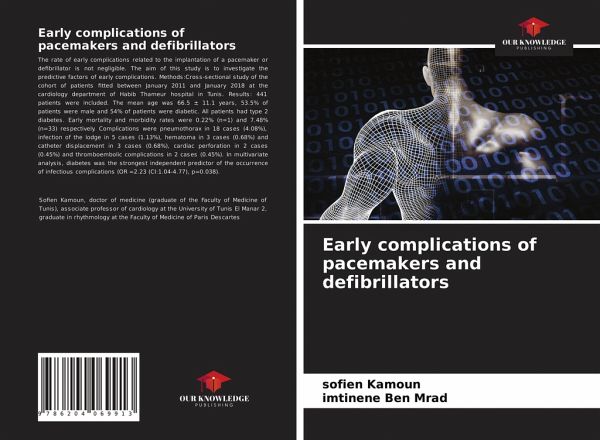
Early complications of pacemakers and defibrillators
Versandkostenfrei!
Versandfertig in 6-10 Tagen
27,99 €
inkl. MwSt.

PAYBACK Punkte
14 °P sammeln!
The rate of early complications related to the implantation of a pacemaker or defibrillator is not negligible. The aim of this study is to investigate the predictive factors of early complications. Methods:Cross-sectional study of the cohort of patients fitted between January 2011 and January 2018 at the cardiology department of Habib Thameur hospital in Tunis. Results: 441 patients were included. The mean age was 66.5 ± 11.1 years, 53.5% of patients were male and 54% of patients were diabetic. All patients had type 2 diabetes. Early mortality and morbidity rates were 0.22% (n=1) and 7.48% (n...
The rate of early complications related to the implantation of a pacemaker or defibrillator is not negligible. The aim of this study is to investigate the predictive factors of early complications. Methods:Cross-sectional study of the cohort of patients fitted between January 2011 and January 2018 at the cardiology department of Habib Thameur hospital in Tunis. Results: 441 patients were included. The mean age was 66.5 ± 11.1 years, 53.5% of patients were male and 54% of patients were diabetic. All patients had type 2 diabetes. Early mortality and morbidity rates were 0.22% (n=1) and 7.48% (n=33) respectively. Complications were pneumothorax in 18 cases (4.08%), infection of the lodge in 5 cases (1.13%), hematoma in 3 cases (0.68%) and catheter displacement in 3 cases (0.68%), cardiac perforation in 2 cases (0.45%) and thromboembolic complications in 2 cases (0.45%). In multivariate analysis, diabetes was the strongest independent predictor of the occurrence of infectious complications (OR =2.23 (CI:1.04-4.77), p=0.038).














